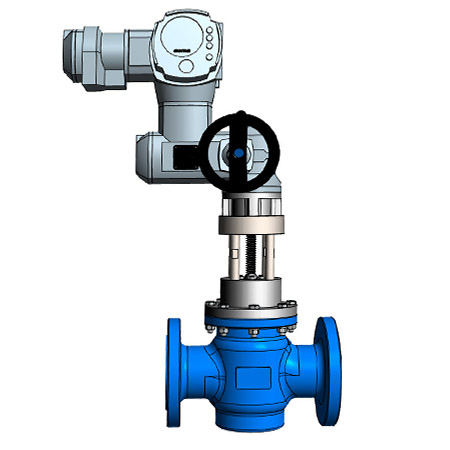Enhancing Operational Efficiency with Advanced Control Valves
Enhancing Operational Efficiency with Advanced Control Valves
Blog Article

Maximize Power Financial Savings and Comfort With Advanced Structure Automation Controls
In the realm of modern architecture and center monitoring, the combination of advanced building automation controls stands as a crucial improvement. The convergence of innovation and sustainability has actually birthed a brand-new period where power performance, comfort optimization, and functional streamlining are no longer far-off aspirations yet achievable facts. By harnessing the power of automation, buildings can adjust, react, and progress in methods that were as soon as unbelievable. The possibility for significant energy savings and enhanced comfort is not simply a promise however a possibility waiting to be fulfilled. This standard shift in building administration holds the essential to opening a world where environmental conscientiousness and occupant well-being sympathetically coexist within the walls of our structures.
Energy Performance Benefits
Energy efficiency advantages can substantially lower power intake and functional expenses in structures. Energy-efficient systems, such as sophisticated structure automation controls, can maximize the use of resources like lighting, home heating, and cooling, leading to lower energy costs over time.
Moreover, improved power efficiency can lengthen the life expectancy of structure devices and systems. By running extra effectively, HVAC systems, light, and other structure parts experience less wear and tear, causing minimized upkeep and replacement costs. Additionally, energy-efficient structures typically command greater property worths and rental rates, supplying long-lasting monetary benefits to owners.
Additionally, energy efficiency can enhance resident convenience and performance. Properly managed interior environments with optimum lights and thermal conditions produce a more favorable and pleasurable work space, resulting in boosted staff member complete satisfaction and efficiency. Overall, the energy efficiency benefits connected with sophisticated building automation controls are multifaceted, including cost savings, ecological stewardship, and occupant health.
Improved Comfort Control
Enhancing convenience control in building atmospheres needs an innovative assimilation of sophisticated automation systems for optimal owner health. By using advanced structure automation controls, facilities can customize the indoor environment to satisfy the certain needs and choices of residents. These systems allow exact policy of lights, ventilation, and temperature level, producing a comfortable and effective environment. Resident contentment and efficiency are carefully linked to thermal comfort, making it necessary to have systems in area that can adapt to changing problems in real-time.
By incorporating these innovative controls, buildings can not only improve comfort however likewise improve energy effectiveness by enhancing system procedures based on real occupancy and use patterns. Inevitably, focusing on resident convenience through sophisticated automation systems leads to a more pleasurable and healthier interior setting.
Operational Effectiveness Improvements

Furthermore, the application of real-time surveillance and analytics devices allows building drivers to identify energy inefficiencies and operational anomalies without delay. By constantly monitoring power usage patterns and system efficiency metrics, modifications can be made in real-time to enhance power intake and guarantee peak functional efficiency. control Full Report valves. Furthermore, incorporating demand reaction strategies into building automation controls can even more improve functional efficiency by dynamically adjusting energy use based upon grid conditions and prices signals
Indoor Climate Optimization
Efficient interior environment optimization is a basic aspect of structure automation controls, ensuring residents' comfort and health while maximizing power savings. By using innovative sensors and controls, building automation systems can continuously readjust and monitor temperature, moisture degrees, air high quality, and ventilation to create an optimum indoor atmosphere. Keeping constant and comfy conditions not just boosts passenger contentment but also boosts productivity and total health.
Interior climate optimization also plays a vital role in power click reference effectiveness. By fine-tuning heating, cooling, and air flow systems based upon real-time data and tenancy patterns, building automation controls can substantially decrease power usage - control valves. As an example, implementing techniques such as demand-controlled ventilation and thermal zoning can help reduce energy waste while ensuring that each location of the building obtains the essential conditioning.

Sustainable Setting Production
Structure automation controls not just enhance indoor environment conditions for power effectiveness and owner convenience yet also lay the structure for developing a sustainable atmosphere with strategic administration of sources and systems. By integrating advanced structure automation innovations, such as sensing units, actuators, and intelligent software, centers can readjust and keep track of energy usage in real-time to reduce waste and decrease their carbon impact. These systems enable predictive upkeep, determining potential problems before they rise and maximizing tools efficiency to improve longevity and efficiency.
Moreover, lasting atmosphere creation extends beyond power management to include water conservation, waste decrease, and indoor air high quality enhancement. Structure automation controls can manage water usage, spot leakages, and make certain proper waste disposal techniques, adding to total sustainability efforts. Furthermore, by keeping an eye on and regulating ventilation and filtration systems, these technologies improve occupant health and efficiency while decreasing energy intake connected with HVAC procedures.
Verdict
In verdict, advanced building automation controls deal considerable benefits in terms of power cost savings, convenience control, operational effectiveness, interior environment optimization, and developing a lasting setting. By implementing these controls, structures can accomplish optimum performance while lowering power consumption and improving owner convenience. It is evident that making use of sophisticated automation technology is important in boosting building efficiency and producing a more sustainable future.
Energy efficiency benefits can dramatically minimize energy intake and operational expenses in structures. Overall, the power performance benefits associated with innovative building automation controls are multifaceted, including expense savings, ecological stewardship, and occupant wellness.
Furthermore, including demand response strategies into building automation controls go to my site can further enhance functional performance by dynamically readjusting power usage based on grid conditions and pricing signals.
Building automation manages not only enhance indoor environment conditions for power effectiveness and resident convenience yet also lay the structure for creating a sustainable setting via strategic management of systems and sources.In final thought, progressed building automation controls deal considerable advantages in terms of power savings, convenience control, operational efficiency, indoor climate optimization, and producing a lasting atmosphere.
Report this page